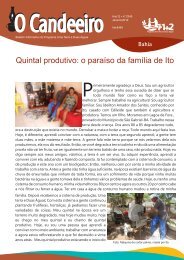16 thousand litres - Plates Cisternas (Inglês)
Over the past decades, ASA and families of Brazil's semiarid region have developed and improved the method of building cisterns. This guidebook aims to share this experience, enabling other people to benefit from this technology that has changed the scenario and the lives of thousands of families in the Brazilian semiarid region. It details the entire process about how to build a cistern with a capacity to store 16,000 liters. This guidebook can support technical teams and development institutions working to promote solutions that enable rural families to improve their access to water. In addition, so that more communities in arid, semi-arid and dry sub-humid regions of the world have autonomy in the construction of their cisterns.
Over the past decades, ASA and families of Brazil's semiarid region have developed and improved the method of building cisterns.
This guidebook aims to share this experience, enabling other people to benefit from this technology that has changed the scenario and the lives of thousands of families in the Brazilian semiarid region. It details the entire process about how to build a cistern with a capacity to store 16,000 liters.
This guidebook can support technical teams and development institutions working to promote solutions that enable rural families to improve their access to water. In addition, so that more communities in arid, semi-arid and dry sub-humid regions of the world have autonomy in the construction of their cisterns.
You also want an ePaper? Increase the reach of your titles
YUMPU automatically turns print PDFs into web optimized ePapers that Google loves.
step-by-step guide for the construction
IMPLEMENTATION:
EXECUTION
Brazilian Semiarid Articulation (ASA)
Nicarágua street, 111, Espinheiro – 52.020-190 Recife/PE
Telephone number. (81) 2121.7666 – Fax: (81) 2121.7629
asacom@asabrasil.org.br – www.asabrasil.org.br
www.facebook.com/articulcaosemiarido
www.instagram.com/articulacaosemiarido
www.twitter.com/asa_brasil
ASA’S COMMUNICATIONS CONSULTANCY (ASACOM)
Fernanda Cruz DRT/PE 3367
Verônica Pragana DRT/PE 2923
Hugo de Lima
PHOTOGRAPHS
Hugo de Lima
PRODUCTION
Angola Comunicação
Content
Anna Terra Miranda
Catarina de Angola
Booklet "Construcción de tecnologías apropriadas. Cisterna de
placas, INTA, 2014”.
Editing
Catarina de Angola DRT/PE 4477
Spelling check
Mariana Reis
Translation
Sara Brito
Ilustrations
Rodrigo Gafa
Editorial Design Project
Tutti Dolly Mélo
REFERENCES
Construcción de tecnologías apropiadas. Cisterna de placas - 1a ed. -
Ciudad Autónoma de Buenos Aires: Ediciones INTA, 2014.
Modelo da Tecnologia Social de Acesso à Água Nº 01 - Cisternas de
Placas de 16 mil litros. Anexo da Instrução Operacional SESAN no 02,
de 08 de agosto de 2017 - Programa Cisternas.
Recife/PE, Brazil. 1ª edition, January de 2021
INTRODUCTION
Water is a common good. Its access must be universal
and guaranteed for people from all places so they can
use it for their needs and activities. Water is life. It is an
essencial good to the guarantee of food and nutritional
security.
Around the world, specially in arid, semiarid and dry
sub-humid areas, people and popular organisations are
in struggle to guarantee access to quality water in a
decentralised way. They act for the proposal and
implementation of access to water politics but also
creating and adapting solutions based on local
knowledge and the climate conditions of each region.
Nowadays, rain has been a source of water
democratisation and has brought autonomy to many
families, specially in arid, semiarid and dry sub-humid
areas from the whole world through the development
of several technologies, like the construction of cisterns,
which are the most popular technology in Brazil.
We present here a step-by-step guide in detail about
the construction process of a plates cistern with the
capacity of storing 16 thousand litres, based on the
model that collects water from the roof of the houses,
implemented in Brazil by the Brazilian Semiarid
Articulation (ASA). This water, after being treated, can
be used with quality to drink and to cook, like it
happens in Brazil. In regions where the water stored in
the cistern doesn’t have the quality to be consumed it
can be used to other needs of the family.
PRESENTATION
Throughout the last decades, ASA and families
from all the Brazilian Semiarid developed and
improved the method of construction of plates
cisterns. The purpose of this booklet is to share
this experience on the construction of cisterns,
enabling other peoples to benefit from this
technology that changed the scenario and life
of thousands of families in the Brazilian
Semiarid.
So that other communities in arid, semiarid and
dry sub-humid areas from the whole world
have the autonomy of building their own
cisterns, this booklet presents a step-by-step
guide in detail of the construction process of a
plates cistern with the capacity to store up to
16 thousand litres. This booklet also can be
used as a support to the technical teams and
funding institutions that work on the promotion
of alternatives that allow rural families to have a
better access to water.
01
THE PLATES CISTERN 05
02
PRECAUTIONS BEFORE STARTING THE CONSTRUCTION
06
03
TOOLS AND MATERIALS
09
04
THE SITE
11
05
MANUFACTURE OF THE PLATES
13
06
MANUFACTURE OF THE BEAMS
21
07
BASE OF THE FLOOR
24
08
FLOOR
28
09
WALLS
30
10
PLASTER
35
11
ASSEMBLY OF THE BEAMS
38
12
ROOF AND OTHER FINAL DETAILS
43
13
EXPECTED WORK SCHEDULE
46
14
HARVESTING WATER SYSTEM
47
15
WITHDRAWAL OF THE WATER
49
16
WHAT IS ASA?
50
01
THE PLATES CISTERN
We will learn about the benefits of storing
rainwater. In addition, we will learn the main
variables to be considered to build a cistern
and the tools and materials we will need.
The shortage of water and the increasing
problems related to climate change affect
many regions from Brazil and around the
world. One way of dealing with this situation is
to harvest and store rainwater to be used in
periods of drought.
We can utilize the stored water for many
purposes, respecting the indications set to
each usage (for example, consumption and
personal hygiene or irrigation for food
production and raising of animals).
There are several types of
cisterns of different sizes
and that can be used to
various purposes. We
chose to present the
plates cistern because it
is a low-cost and easy
maintenance option that
offers autonomy for the
management of potable
water to the families.
To have a reservoir of rainwater can
improve our families’ daily life, as long as
it is kept clean and in good condition
and that a good administration of the
equipment is made.
Through this booklet you can learn how
to build your own 16 thousand litres
plates cistern. Let’s go!
05
02
PRECAUTIONS BEFORE
STARTING THE CONSTRUCTION
A great amount of water available is necessary to build a plates cistern.
Make sure the water used is of good quality. In regions where the water is rich in sulphur,
the use of pozzolanic cement is recommended, because the sulphur negatively reacts with
usual cement.
The size of the plates cistern needs to be associated with the size of the harvesting area
and the amount of rain in the region. It is very important to do this analysis before starting
the construction. To do this analysis you have to know the amount of water that can run into
the cistern and the size of the harvesting area, be it a roof or a big pavement. With these
information in hand the count is simple: multiply the size of the harvesting area by the
amount of rain (in millimetres). This way, you will know the ideal size for your reservoir.
HARVESTING AREA
AMOUNT OF RAIN IN MILLIMETRES
IDEAL SIZE OF
THE RESERVOIR
Did you know?
It is possible to build
the plates cistern
with other
measurements
adapting the quantity
of materials and the
size of the moulds.
Important!
The World Health
Organisation (WHO)
recommends the
consumption of 50
litres of water per day
by person for personal
hygiene and food
consumption.
06
To collect rainwater we must implement a small harvesting system that includes:
1
2
3
4
5
One harvesting area, which are usually roofs.
One filter and prefilter system.
One system for the channeling of water through gutters and PVC pipes.
One storage area, like cisterns or tanks.
One extraction system.
1
3
2
4
5
To store rainwater we also need to know some data:
The annual precipitation value and its
monthly distribution. These two values
will allow us to analyse the annual value
we will adopt for the project.
The surface of the available
harvesting area, which are the measures
of the roof where the water we’ll collect
will fall.
The family’s average consumption of
water and the usage we hope to make of
the stored water. armazenada.
If the roofs are not in a good
condition to receive the rain we can
restore them to improve water
harvesting.
The capacity the cistern will have, in
other words the amount of water the
cistern will be able to store.
If the water is used for human
consumption, it is necessary to do some
treatment.
07
Useful information!
Research about filtering systems and rainwater treatment, specially if the water will be
used for family consumption (see pages 47 and 48).
Assess if the technology is suitable for your region.
3,5 m (diameter)
These measures were calculated for an annual
average precipitation of 700 mm with eight
months of dry season and a harvesting area of
30 m2. We consider the water will be used by a
family of five people.
Here we will concentrate on the construction of
a plates cistern, a system commonly used in the
Brazilian semiarid where more than one million
and two hundred thousand cisterns were
already implemented.
The plates cistern we will build will be
cylindrical, covered and semi-perforated. It is
3.5 metres in diameter x 1.8 metres in height
and it has the capacity to store up to 16
thousand litres.
Reminder!
In a 1m 2 area
with 1 millimetre
of rainfall we
collect 1 litre of
water.
08
03
TOOLS AND MATERIALS
tools
Iron cutter
Shovel
Broom
Plumb bob
Hammer
Tape measure
Trowel
Bucket
Sand sieve
Paintbrush
Level
Wheelbarrow
09
materials
Two cubic metres of fine sand;
One cubic metre of coarse sand;
Half a kilo of common wire, for the tying;
16 kilos of number 12 galvanised steel wire;
One kilo of number 18 annealed wire;
20 kilos of CA 50 ¼” (6,35 MM) (a quarter of an inch) ribbed steel rod;
Four kilos of concrete waterproofing;
Sticks or twigs to the supporting of the plates;
12 metres of 75 millimitres PVC pipe;
One 2.12 metres wood beam;
12 six metres 8 millimetres iron bars;
Half a cubic metre of number one or 19 millimetres gravel;
16 sacks of cement;
10 kilos of hydrated lime for the painting;
Water for the construction;
26 kilos of 30 GSG (0,399MM) flat galvanised sheet;
Half a metre of nylon netting;
One sieve filter;
One manual pump.
10
04
THE SITE
choosing the site for the construction
To choose the site for the plates cistern construction you must pay attention
to some points:
Avoid places with many rocks and
stones because they may hinder the
digging of the hole.
The cistern must be built away from trees
with deep roots that may cause its
structure to crack.
It is important the site is at a
minimum distance of 15 metres from
corrals, cesspits, trash deposits and other
sources of water contamination.
It’s fundamental the cistern is built next
to the rainwater harvesting area, like the
roofs of the houses.
If the water will be used for
human consumption it is
important to place the cistern
next to the kitchen, this will
facilitate the domestic use.
Important tip!
Check if the soil is compact and solid.
If it’s soft it is necessary to do the
compaction with an adequate tool.
11
4,6 m
5,1 m
digging the hole
To begin with the construction, we dig a 1,20 metres in height hole. To do that we mark
the soil, drawing a circle of 2.30 metres radius. That way, the hole for the cistern will have a
diameter of 4.60 metres, leaving a space of approximately half a metre for the work area of
the bricklayers.
Important
tip!
It is possible to use
a 2.30 metres
piece of string tied
to a stake at the
center of the circle
to draw all its
diameter.
12
05
MANUFACTURE OF
THE PLATES
With moulds, we’ll build the plates that will be used on the wall and on the roof of the cistern.
The plates can be manufactured on the same place where the cistern will be built and they
are made of precast concrete. The moulds for its manufacturing can be made of wood or
iron.
wall • moulds
The mould for the wall plates can
be made of wood or metal and
must have a slight curvature in its
smaller sides, allowing the walls
to get a round shape.
0.5 m
4.6 m
3 cm
0.6 m
This is calculated as follows:
0.5 m
On the 4.60 m diameter marking
made on the soil, you must lean a 0.5
m wire on the ground giving it the
form of the curve. This will be the
curvature of the mould.
Measuring 0.5 metres width, 0.6 m
height and being 3 cm thick, the mould
has a little mark that assists the work of
assemble of the walls, making it more
diligent and precise.
13
Important
tip!
Make a layer of
sand leveled to the
ground where the
plates will be
manufactured.
We need to make
three sets of 21 plates
for the wall, but it is
recommended to
make some more in
case of them breaking
or cracking during the
transfer and
installation process.
For all the measurements
we will use a tin that holds 20kg
of sand as baseline.
Ratio os the mass: 4 tins of
sand to 1 tin of cement.
14
wall • step-by-step
1
Make a layer of fine sand leveled to the
ground where the plates will be
manufactured.
2
Drag the mould on the sand to make sure
it take the round shape of the plate when
filled with the concrete.
Lean the mould and fill it with the
concrete.
3
15
4
Distribute the concrete inside the
mould giving special attention to
the corners.
Pass a piece of wood over the
mould to remove all the surplus
of concrete and level it.
5
6
Wait a few minutes to take off the
mould holding the corners
diagonally so the shape of the plate
is not altered.
16
In all the plates, make a mark sinking a
spoon near the edge as it can be seen
here. This will make the suppporting
easier when it’s time to assemble the
wall.
7
In 21 plates it is necessary to make a 8 x
8 centimetre cut while the concrete is
still fresh. This will be the upper row of
plates, where the roof beams will be
leaned over.
8
In just one of the plates make a hole
using a 100 millimetres PVC pipe. This
hole will be the water escape when it
reaches the full capacity of the cistern.
9
Important!
The drying period of the
plates is about 24h in the
summer time and 48h in
the winter time,
depending on the local
climate. It is necessary to
wet the plates every three
hours during the drying
period to avoid damage
and craks.
17
roof • moulds
To make a wood or metal mould as it can be seen
on the drawing and on the pictures.
The ratio of the mass is the same used on the
walls: 4 tins of sand to one tin of cement.
It’ll be 21 plates for
the roof and the
manufacture process
is the same as the one
of the plates for the
wall. It is suggested to
make 2 or 3 extra
plates in case of
breaks and cracks.
Important
tip!
Remember to make
the sand layer well
leveled to the ground
where the plates will
be built.
18
roof • step-by-step
Fill the moulds with concrete, spreading
it on the whole area and removing the
surplus with a piece of wood.
1
2
Put them side by side in opposite
position to take advantage of the space.
3
In one of the plates, on the bigger part,
make a hole using a 110 millimetres PVC
pipe. That will be the entrance of water
to the cistern.
19
4
In case of using a suction pump, it’s necessary
to make a hole in one of the plates. The hole
must be from 32 mm to 44 mm depending on
the size of the ducting of the pump.
5
Let them dry for the same period of time
as the plates for the wall.
6
During the drying period it’s important to
wet the plates for the wall and for the
roof every three hours, specially in dry
climates and places under strong
sunlight to avoid crackings.
On the following day to the
manufacture of the plates, they can be
leaned on a wall to facilitate the drying.
20
06
MANUFACTURE OF
THE BEAMS
Let’s learn how to manufacture the 21 beams that will support the roof of the plates cistern.
iron bars for the beams
The beams are made with an iron bar
inside them. So the first thing you have to do
is cutting 21 8 mm iron bars of 1.85 length
each. It is recommended to cut 2 or 3 more
for backup.
With the help of a tool or a pipe, bend
one of the ends of all the iron bars, making a
hook of approximately 10 centimetres.
beams • moulds
To make the beams we will need a mould
with the following measures: 1.30 m length, 6
cm width on one end and 8 cm width on the
other and from 2 to 3 cm thick.
The mould has a gap in the middle of the extremity where the iron bar will be
inserted during the assembly of the beam. In the picture we can see an adpated
mould from a rectangular form. In one of the extremities, a small piece of wood
was crossed diagonally to obtain the desired form.
21
Ratio of the mass: 2 tins of sand,
2 tins of gravel and 2 tins of
cement. Water for the mixture.
Important!
Remember the
mixture must be a
little dry to allow
the immediate
release of the
mould.
beams • step-by-step
1
Like it was made with the plates, start
making a layer of sand leveled to the
ground where the beams will be
manufactured.
2
Fill approximately one half of the
mould with concrete.
22
3
Put the iron bar inside, with the hook going out the narrower part of the mould.
4
Fill the rest of the mould with concrete until covering up all the interior.
5
On the opposite extreme of the hook make a small bend with the trowel to have a
more rounded finish.
6
Remove the surplus of cement with the piece of wood and pat to facilitate the removal
of the mould.
7
Let it dry for the same period of time and following the same recommendations given
for the plates.
23
07
BASE OF THE FLOOR
When the plates and beams are ready it’s time to start assembling the plates cistern. But first
we need to make the base.
base of the floor • materials
Seven 20 cm iron stakes;
Eight 8 mm and 3,60 m length iron bars;
One kg of wire;
One 8 mm iron bar longer than 6 m length;
Three 8 mm iron bars under 3 m lenth.
base of the floor • step-by-step
1
In an open and clean space,
different from the cistern’s
site, we mark on the floor a
circle of 1.75 m radius that
equals 3.5 m diameter. It’s
important the soil is very
compact.
24
2
Use the 8 mm iron bar of 6 m in
length to form the circle that was
marked, tying the iron ends with
wire and a stake.
Cut 8 8mm iron bars of 3.6 m in
length and put the first one in the
middle of the circle, tying its
extremities with wire. Put the
second one perpendicular to the
first.
3
4
Then put the other 6 remaining
iron bars in a way the structure has
16 radius formed by iron bars.
25
5
Put the other 8 mm iron bars in a
concentric way with a distance of
approximately 55 cm from the main
circle tying the ends with wire.
6
Let’s cut the wires that are tying the
structure to the stakes and transfer the
base to the interior of the well where
the cistern will be built. Put it right in the
center.
another alternative: squared base
It is possible to build the base
with a squared interior formed by
25 x 25 cm squares made with 8
mm iron bars.
25 x 25 cm
This kind of structure requires 3
extra iron bars apart from the
ones used on the circular one.
26
We can see in both cases
the grid doesn’t take the
full diameter of the well
since the cistern will have a
3.5 m diameter. The
remnant of space is what
will allow us to work
comfortably on the
construction of the walls.
27
08
FLOOR
To make the floor we prepare a concrete mixture. The concrete must be 10 centimetres
thick.
Before applying it it is recommended to lift the base grid 4 or 5 centimetres up. We do this
by putting rocks at certain points. This way the grid is embbed inside the concrete and it
works correctly.
Ratio of the mass: 2 tins of coarse sand,
2 tins of gravel and water for the mixture.
Tip!
It is
recommended to
do this task using
the hand level.
floor • step-by-step
1
Start filling the grid with
concrete from the
outside in.
28
2
It is important to keep leveling the
floor throughout the structure
construction, specially the more
external area.
After finishing the floor, the
external perimeter is traced (a
radius of 1.75 m) with a wire tied to
the central stake, that will be the
final measure of the floor. We will
start putting the plates on this
mark as soon as they are dry.
3
4
Make the finish of the borders
outside the marked perimeter.
29
09
WALLS
Let’s learn how to assemble the three rows of plates that will form the wall of the cistern.
propping system
Trere are three systems. They can be used alone or in combination to prop the plates up
while we build the wall.
Using thin sticks or
branches.
Using wood beams or
long thick trunks.
Making little clamps or
iron guides that will tie
two plates at their
intersection.
Ratio of the mortar for the grouting: 2 tins of
sand to 1 tin of cement.
first row • step-by-step
1
Once we choose the propping system, we prepare
the mortar to assemble the plates and carefully
transfer them to the interior of the well. We can
lean them on the walls.
30
Put the mortar on the perimeter and stick
the first plate. Continue the same way
with the other plates following the round
mark.
2
Each time we stick a plate we underpin
the internal and external sides with
branches for support like we see on the
pictures. The inside branch goes at the
mark we did with a spoon while
moulding the plates.
3
We leave a 2 cm distance between one
plate and the other. Later we will fill it
with mortar.
4
31
It is important to use the plumb bob
every time we stick a plate to make sure
it is straight.
5
With the mortar we make a kind of
excess border on both sides of the plates
next to the ground so they fix well on the
base.
6
from the second row on • step-by-step
It’s important to consider before the beginning:
If you’re using the
system with branches
you have to cut longer
branches because
these rows are farther
from the ground.
The little mark or
incision the plates present
in the middle of the upper
part is the guide to place
them correctly, sticking
every new plate between
the notch on the plates of
the row below.
Leave one plate
out of place for now
so you can work
comfortably, going
inside and out of the
well.
32
Attention!
As you build the wall with the plates it’s necessary to calculate the space between
them so that the 21 plates can be put in place. The space can’t be too big or too
little, but in case this happens it can be necessary to cut a plate into the right size
to complete the row.
1
We follow the same way to put the second
row of plates for the wall into place, using
the chosen propping system. The plates of
the upper wall are stuck overlapping the
joints on the first row of plates to
complete the whole wall.
2
Each time a row is completed, we encircle
all the circumference with number 12
galvanised steel wire. We repeat this
procedure seven times. In other words,
every row of plates will be encircled
externally by seven turns of wire, as the
pictures show. This wire works to
strengthen the wall of the cistern.
3
We put up the third row of plates for the
wall in the same way we did the others,
using a plumb bob and putting the joints
perfectly together inside and outside. We
do that paying attention to the lines and
plates.
Reminder!
33
On the third row we will
use the plates with a
cut; they will be at the
top and will support the
beams.
We encircle the third row with nine to
eleven turns of wire. It is important at
least three turns of wire are placed at the
spaces where the beams will be put.
4
On this row we put the plate with the hole for
the water escape. We put it in a convenient
place, where there’s the possibility of taking
advantage of the overflow to irrigation and so
it doesn’t flood the front of the house. This
hole must be covered with a netting to
prevent the entry of little animals, dirt and
dust.
5
Reminder!
To use the plumb
bob to put every
plate into place and
make the perfect
union in all the lines.
34
10
PLASTER
external plaster
As soon as we finish the first two rows of the wall and putting the wire around them, we
can start to plaster the external part. It is important that the plaster covers all the wire of
the structure.
Ratio of the mass: 5 tins of sand
to 1 tin of cement and water.
step-by-step
1
Brush the walls to remove the loose
sand and apply two thick layers,
plastering until covering the whole
wall. It is important all the turns of
the wire are covered.
2
Plaster a thin layer only on the
section of the cistern that will not
be buried.
After 8 hours the
props can be
removed and then
the plaster can be
made on the
internal wall.
35
internal plaster
We do this plaster as soon as the wall with the three rows of plates is finished. The whole
wall must be well covered with a good finish. It’s important that no section of the internal
wall remain without plaster.
Waterproofing!
For the internal plaster, you must add to the mixture some waterproofing material and
apply it on the entire wall and floor after the plaster is finished.
The mixture is of 1 litre of waterproofing
to 10 litres of water.
Ratio of the mass: 3 tins of sand to 1
tin of cement and the water mixed
with the waterproofing material.
step-by-step
1
With the mixture we plaster the interior
covering the entire wall. Smooth it to
have a good finish. This plaster must not
be too thin. It’s important to pay
attention if the entire wall is plastered
and there are not any cracks.
36
On the floor of the cistern we mix the
mass and the diluted waterproofing.
2
3
Finishing the
plaster we make a
mortar with water
and cement
(fifty-fifty) to brush
the wall and the
floor.
After everything is ready we seal the
ditch around the cistern, ensuring it’s well
strengthened.
4
37
11
ASSEMBLY OF THE BEAMS
central pillar
This pillar will help us putting
the roof together and after
some days we will remove it
from the plates cistern. Here’s
how we do it:
0,5 metres
We cut a 2.12 m length wood
beam.
2.12 metres
We put two 50 cm length
pieces of wood transversally in
one extremity.
On the other extremity we put
a little shorter piece of wood.
cement cover
To build a cement cover with
a diameter of 50 cm and
from 8 to 10 centimetres
thick.
Inside it you must put an 8
mm iron bar and finish it
with a handle, like the image
shows.
38
step-by-step
1
At the center of the cistern we apply
some of the mixture in the form of a
circle with a diameter of approximately
40 cm.
Upon this mixture we fix the central
pillar with the end with the two pieces
of wood facing up.
2
3
We fix the pillar with four wires crossed
perpendicularly. We also could fix them
with two pieces of wood, propped and
tied.
39
4
We put the cement cover over the pillar,
carefully.
5
We put the beams placing the ends with
the hooks at the center with caution to
keep the central pillar and the cement
cover balanced.
6
We start with one and then put another
at its opposite side for a better balance.
40
7
Each beam’s iron hook is placed facing
up, side by side, forming a little circle at
the cement cover.
8
It may be necessary to scratch a little
the edges of the extremities of some
beams so they fit better.
9
After all the beams are in their places
we encircle the hooks with many turns
of wire.
10
Put concrete between the cover and
the hooks. It must be pretty firm
because we will remove the central
pillar after five days.
Observe:
The concrete cover play the
function of a mould, propping the
concrete so it doesn’t fall through
the filling of the beam’s joints.
41
another way of building the central pillar
This pillar will help us putting the roof together and after some days we will remove it from
the plates cistern. Here’s how we do it:
Use the same pole or wooden beam
but here you put a cover with a diameter
of 50 cm (like an oil barrel cover) instead
of the concrete cover, fixed to the beam
by four pieces of wood.
It is installed the same way as the
former: upon a little mixture of concrete
at the center of the floor of the cistern.
We can fix it with a wooden cross,
tying the pillar with a wire so it remains
well fixed.
The beams are placed the same way
as in the previous example.
42
12
ROOF AND OTHER
FINAL DETAILS
step-by-step
After the assembly of the beams with
one of the two systems of central pillars
we put the roof plates, one by one,
leaning them on the beams with their
smooth side facing in.
1
2
We grout the plates to fix them
together.
3
We put the plate with the hole for the
entry of water at the most convenient
place for it to receive the water. For
example, next to the roof gutter to
channel the rainwater.
Important!
This entrance must
remain closed while
there’s no water
harvesting to avoid
the entry of little
animals, dirt, trash,
etc.
43
We complete the plaster of the entire
cistern with the same material of the
external wall.
4
Around the plate where the door will be
installed we make a frame to avoid the
water from flowing into the cistern
directly. This will protect the cistern from
earth and will facilitate the installation of
the door.
5
Tip!
Until the door for the plates cistern is
installed we leave one plate loose so it can be
easily removed allowing the entry and exit of
a person.
Important!
It’s very important to install the door as quickly as possible and to lock it up with a padlock
for safety reasons, specially if there are children around that may have access to the cistern.
44
6
With a flexible material like a thin hose
we encircle the cistern on the upper
section of the wall, around 10 cm down
from the limit with the beggining of the
roof and we make a flange filling this with
plaster mixture. This finish is a
reinforcement to the place where the
beams are laid.
7
We paint the exterior of the plates cistern
with lime or water-based paint. This
refflects sunlight, reducing the
temperature inside the cistern,
protecting it from humidity and
diminishing the possibility of future
cracks and dilations.
Here we finish the step-by-step guide for the construction of the plates cistern.
45
13
EXPECTED WORK
SCHEDULE
The process of construction of a plates cistern takes from 4 to 5 days with a team of three
or more people.
There are tasks that can be carried out in advance:
The digging of the hole where the cistern will be built.
The manufacture of the moulds for roof, wall and beams.
The gathering of all the tools and materials.
DAY
ACTIVITY
DAY 1
Manufacture of the plates
Construction of the base for the bottom of the cistern
Placement of the base grid and the construction of the floor
Building of the wall, wiring and external plaster
DAY 4
Assembly of the roof, internal and external plaster
Final details: door, finish
Lime painting
46
14
HARVESTING
WATER SYSTEM
tips to store clean water
Clean water when stored probably won’t
lose quality over time.
Make sure the subsequent treatment to
eliminate pathogens is effective.
The water we drink must be clean,
odourless and free of sediments.
functioning
To make sure the
water is clean and
have the quality
needed, a filter
system before the
water enters the
cistern is
necessary.
The roof collects the first rainwater that enters
the prefilter with sticks, leaves and earth. It is
filled and the plunger covers the entrance of
the prefilter. The remaining water, already
clean, passes through the pipe directly into
the cistern.
meet 2 kinds of prototype
prototype 1
Based on the Brazilian Semiarid
Articulation’s (ASA) proposal. It
has a fast prefilter for rainwater
(float valve).
prototype 2
This prototype has a prefilter and
a filter system before the water
enters the cistern.
47
prefilter
Holds bigger particles like leaves, sticks and bugs. It is used like a netting or a plastic
grid.
sedimentation pond and decanting process
They reduce the speed of the water as it goes down, this way some solid elements stay
at the bottom of this structure and don’t go into the cistern.
filter
Allows the thinner solid residues and the dissolved particles to be removed. There are
commercial and homemade alternatives.
Gutters
Prefilter
Gutters
Prefilter
Filter
Sedimentation
pond and
decanting
process
Sedimentation pond
and decanting process
Filter
48
15
WITHDRAWAL
OF THE WATER
To withdraw the water from the plates
cistern the installation of a suction pump
system is recommended. This way we
avoid a possible contamination through
buckets, trash bins or others and reduce
the probability of accidents.
If it’s not possible to use a pump, you can
use a bucket exclusively for this purpose
and make sure the bucket is always clean
before putting it into the cistern.
how to avoid the contamination of the
water after it is withdrawn from the cistern?
The water of the first rain must be discarded and must not go directly into the cistern,
because it may contain dirt from the roof;
The cistern must always be tightly covered and the water must be withdrawn for usage
always through the manual suction pump;
The water that will be consumed must be treated using sodium hypochlorite or sanitary
water.
other cautions that can improve the
cleaning of the system
Keep the roof and the
gutters that channel the
water well cleaned,
specially before the
beginning of the rain
period.
The PVC pipes that
take the water from the
roof to the cistern must
be stored throughout the
dry season to avoid them
from cracking.
Discard the first
rainwater and avoid it
getting into the cistern.
49
It is recommended to
clean the cistern every
year. It’s important this
task is made by a pair so
one person can be inside
the cistern and the other
one outside the cistern in
case any inconvenience
happens during the
cleaning.
Make sure no big or
little animals (rodents,
frogs) have access to the
inside of the cistern.
Place nettings or plastic
covers over the
entrances.
The annual cleaning
must be made on the
entire cistern, using a mix
with a ratio of one litre of
sanitary water or chlorine
to 5 litres of pure water.
This booklet is
available in
Portuguese,
Spanish, French and
English.
This booklet was
financially
supported by FAO.
You can also watch
the video about the
construction of the
plates cistern with
subtitles in the same
languages. All this
contents are available
at the Brazilian
Semiarid Articulation’s
website:
www.asabrasil.com.br
16
WHAT IS ASA?
The Brazilian Semiarid Articulation, ASA, is a network that for over 20
years proposes and implements politics for the coexistence with the
Semiarid, developing the Training and Social Mobilisation for Living with
the Semiarid Program. Its action, through the implementation of
rainwater harvesting social technologies, has taken water to more than
one million people, democratising the access to water in all the Brazilian
Semiarid region.
ASA’s experience is also shared with arid, semiarid and dry sub-humid
areas from the whole world. Among its actions of implementation of
rainwater harvesting technologies are the 1 Million Cisterns Program
(P1MC), the Cisterns at the Schools Program and the One Land and Two
Waters Program (P1+2).
50
IMPLEMENTATION:
















